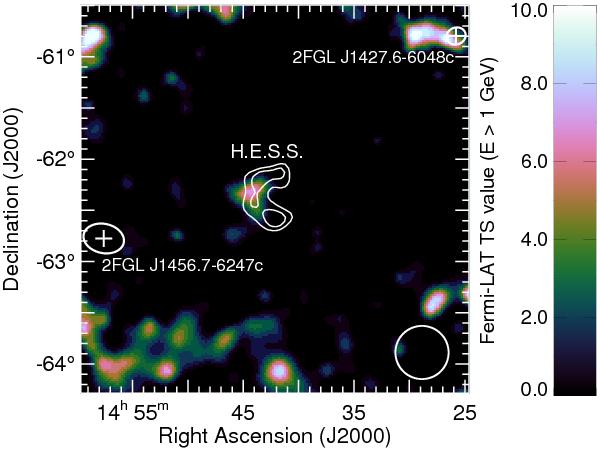Constraints on cosmic-ray efficiency in the supernova remnant RCW 86 using multi-wavelength observations
Abstract
Context. Several young supernova remnants (SNRs) have recently been detected in the high-energy (HE; 0.1 < E < 100 GeV) and very-high-energy (VHE; E > 100 GeV) gamma-ray domains. As exemplified by RX J1713.7-3946, the nature of this emission has been hotly debated, and direct evidence for the efficient acceleration of cosmic-ray protons at the SNR shocks still remains elusive.
Aims: We study the broadband gamma-ray emission from one of these young SNRs, namely RCW 86, for which several observational lines of evidence indirectly point towards the presence of accelerated hadrons. We then attempt to detect any putative hadronic signal from this SNR in the available gamma-ray data, in order to assess the level of acceleration efficiency.
Methods: We analyzed more than 40 months of data acquired by the Large Area Telescope (LAT) on-board the Fermi Gamma-Ray Space Telescope in the HE domain, and gathered all of the relevant multi-wavelength (from radio to VHE gamma-rays) information about the broadband nonthermal emission from RCW 86. For this purpose, we re-analyzed the archival X-ray data from the ASCA/Gas Imaging Spectrometer (GIS), the XMM-Newton/EPIC-MOS, and the RXTE/Proportional Counter Array (PCA).
Results: Beyond the expected Galactic diffuse background, no significant gamma-ray emission in the direction of RCW 86 is detected in any of the 0.1-1, 1-10 and 10-100 GeV Fermi-LAT maps. The derived HE upper limits, together with the H.E.S.S. measurements in the VHE domain, are incompatible with a standard Ep-2 hadronic emission arising from proton-proton interactions, and can only be accommodated by a spectral index Γ ≤ 1.8, i.e. a value in-between the standard (test-particle) index and the asymptotic limit of theoretical particle spectra in the case of strongly modified shocks. In such a hadronic scenario, the total energy in accelerated particles is at the level of ηCR = E_{CR/ESN ∼ 0.07 d22.5 kpc/bar{ncm-3} (with the distance d2.5 kpc ≡ d/2.5 kpc and the effective density bar{ncm-3} ≡ bar{n}/1 cm-3), and the average magnetic field must be stronger than 50 μG in order to significantly suppress any leptonic contribution. On the other hand, the interpretation of the gamma-ray emission by inverse Compton scattering of high energy electrons reproduces the multi-wavelength data using a reasonable value for the average magnetic field of 15-25 μG. In this leptonic scenario, we derive a conservative upper limit to ηCR of 0.04 d22.5 kpc/bar{ncm-3}. We discuss these results in the light of existing estimates of the magnetic field strength, the effective density and the acceleration efficiency in RCW 86.
- Publication:
-
Astronomy and Astrophysics
- Pub Date:
- September 2012
- DOI:
- 10.1051/0004-6361/201219896
- arXiv:
- arXiv:1207.6285
- Bibcode:
- 2012A&A...545A..28L
- Keywords:
-
- ISM: individual objects: RCW 86;
- ISM: individual objects: G315.4;
- 2.3;
- ISM: individual objects: MSH 14;
- 63;
- gamma rays: general;
- ISM: supernova remnants;
- Astrophysics - High Energy Astrophysical Phenomena
- E-Print:
- Accepted for publication in A&
